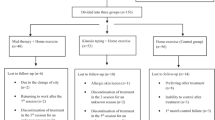Abstract
Purpose
This study was carried out to examine the relationship between rest, activity, and nighttime pain and grip and isokinetic muscle strength of the wrist muscles in individuals with lateral epicondylitis.
Methods
Fifty-six sedentary individuals aged between 18 and 65 years diagnosed with unilateral lateral epicondylitis volunteered to participate in the study. The level of rest, activity, and nighttime pain was evaluated with visual analog scale (VAS). The grip strengths of both arms were evaluated by averaging a maximum of three grip strength measurements using a hand dynamometer. The strength of both wrist flexor and extensor muscles were evaluated with isokinetic dynamometer at angular velocities of 60 and 180°/s with five and 15 concentric repetitions respectively.
Results
There was no significant relationship found between the affected side’s grip strength and isokinetic muscle strength with rest, activity and nighttime pain (all P > 0.05). However, there was a difference observed between the affected and unaffected side in grip strength and isokinetic strength measurements of all wrist muscles (all P < 0.05); the unaffected side values were found to be higher.
Conclusion
The result of this study found no correlation between the stated level of pain and the true muscle strength in the affected hand. In line with these findings, we think that assessments involving strength can be made in other musculoskeletal problems where pain is present. However, the findings may not reflect the true muscle strength which will tend to be underrated.


Similar content being viewed by others
Data availability
The datasets analyzed for the current study are available upon reasonable request.
References
Ma KL, Wang HQ (2020) Management of lateral epicondylitis: a narrative literature review. Pain Res Manag 5:6965381. https://doi.org/10.1155/2020/6965381
Vicens G, Seijas R, Sallent A et al (2017) Tennis elbow pathogenesis. Int J Orthop 4(3):767–769
Sağlam G, Aküzüm F, Çetinkaya Alişar D (2022) Assessment of psychiatric disorders and sleep quality in chronic lateral epicondylitis. Agri 34(3):193–199
Moradi A, Pasdar P, Mehrad-Majd H et al (2019) Clinical outcomes of open versus arthroscopic surgery for lateral epicondylitis, evidence from a systematic review. Arch Bone Joint Surg 7(2):91–104
Park HB, Gwark JY, Im JH et al (2021) Factors associated with lateral epicondylitis of the elbow. Orthop J Sports Med 9(5):23259671211007734. https://doi.org/10.1177/23259671211007734
Lenoir H, Mares O, Carlier Y (2019) Management of lateral epicondylitis. Orthop Traumatol Surg Res: OTSR 105(8S):S241–S246
Landesa PL, Leirós RR (2022) Physiotherapy treatment of lateral epicondylitis: a systematic review. J Back Musculoskelet Rehabil 35(3):463–477
Lucado AM, Kolber MJ, Cheng MS et al (2012) Upper extremity strength characteristics in female recreational tennis players with and without lateral epicondylalgia. J Orthop Sports Phys Ther 42:1025–1031
Karabinov V, Georgiev GP (2022) Lateral epicondylitis: new trends and challenges in treatment. World J Orthop 13(4):354–364
Dorf ER, Chhabra AB, Golish SR et al (2007) Effect of elbow position on grip strength in the evaluation of lateral epicondylitis. J Hand Surg 32(6):882–886
Abboud J, Lessard A, Piché M et al (2019) Paraspinal muscle function and pain sensitivity following exercise-induced delayed-onset muscle soreness. Eur J Appl Physiol 119(6):1305–1311
Latey PJ, Burns J, Hiller CE et al (2017) Relationship between foot pain, muscle strength and size: a systematic review. Physiotherapy 103(1):13–20
Karas V, Hussey K, Romeo AR et al (2013) Comparison of subjective and objective outcomes after rotator cuff repair. Arthroscopy 29(11):1755–1761
Şahinoğlu E, Ünver B, Yamak K (2021) The relationship of range of motion and muscle strength to patients’ perspectives in pain, disability, and health-related quality of life in patients with rotator cuff disease. Ir J Med Sci 190:177–183
Pienimäki T, Tarvainen T, Siira P et al (2002) Associations between pain, grip strength, and manual tests in the treatment evaluation of chronic tennis elbow. Clin J Pain 18(3):164–170
Holmedal Ø, Olaussen M, Mdala I et al (2019) Predictors for outcome in acute lateral epicondylitis. BMC Musculoskelet Disord 20:375
Macdermid JC, Silbernagel KG (2015) Outcome evaluation in tendinopathy: foundations of assessment and a summary of selected measures. J Orthop Sports Phys Ther 45(11):950–964
Johns N, Shridhar V (2020) Lateral epicondylitis: current concepts. Aust J Gen Pract 49(11):707–709
Vaquero-Picado A, Barco R, Antuña SA (2017) Lateral epicondylitis of the elbow. EFORT open reviews 1(11):391–397
Sullivan JK, Shrestha S, Collins JE et al (2020) Association between changes in muscle strength and pain in persons with meniscal tear and osteoarthritis. Osteoarthr Cartil Open 2(3):100072
Bartholdy C, Juhl C, Christensen R et al (2017) The role of muscle strengthening in exercise therapy for knee osteoarthritis: a systematic review and meta-regression analysis of randomized trials. Semin Arthritis Rheum 47(1):9–21
Wadsworth C, Nielsen DH, Burns LT et al (1989) Effect of the counterforce armband on wrist extension and grip strength and pain in subjects with tennis elbow. J Orthop Sports Phys Ther 11(5):192–197
Author information
Authors and Affiliations
Contributions
All authors contributed to the research strategy, evaluations, research question design, and data analysis strategy. All authors read and approved the final manuscript.
Corresponding author
Ethics declarations
Ethics approval
All procedures of the study comply with the principles of the Helsinki Declaration (2008), approval for this study was obtained from Ankara Yıldırım Beyazıt University Social and Humanities Ethics Committee (2023/06–260).
Consent to participate
Informed consent was obtained from all participants included in the study.
Competing interests
The authors declare no competing interests.
Additional information
Publisher's Note
Springer Nature remains neutral with regard to jurisdictional claims in published maps and institutional affiliations.
Rights and permissions
Springer Nature or its licensor (e.g. a society or other partner) holds exclusive rights to this article under a publishing agreement with the author(s) or other rightsholder(s); author self-archiving of the accepted manuscript version of this article is solely governed by the terms of such publishing agreement and applicable law.
About this article
Cite this article
Akınoğlu, B., Shehu, S.U., Yılmaz, A.E. et al. Investigating the relationship between pain level and grip and wrist muscles strength in individuals with lateral epicondylitis: is pain a barrier to strength assessment?. International Orthopaedics (SICOT) 48, 651–656 (2024). https://doi.org/10.1007/s00264-023-06068-2
Received:
Accepted:
Published:
Issue Date:
DOI: https://doi.org/10.1007/s00264-023-06068-2




